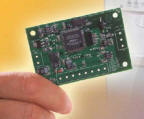January 2006
![]()
AutomatedBuildings.com
[an error occurred while processing this directive]
(Click Message to Learn More)
January 2006 |
[an error occurred while processing this directive] |
|
balance system supply and demand |
Michael Kintner-Meyer Like to know more about GridWise? |
What can home appliances do to help ensure the reliability of the electricity grid? A lot—if they employ smart control technology.
|
|
|
|
|
|
|
|
|
|
|
|
|
|
|
|
|
|
|
|
|
[an error occurred while processing this directive] |
Engineers at Pacific Northwest National Laboratory have developed the Grid Friendly™ appliance controller, a distributed control technology that transforms household appliances into full partners in grid operations. The controllers would be part of the control logic of appliances such as clothes dryers, refrigerators, air conditioners and water heaters and continually monitor fluctuations in the power grid. In times when the controller senses that the grid is under stress, it would automatically shut down specific subcomponents in an appliance for seconds or a few minutes to give grid operators time to stabilize the system.
How it works: Throughout each of the three interconnected electricity systems that comprise the North American power grid, all power plants’ generators rotate synchronously at 60 Hz as if they were one big machine. Using a simple computer chip to monitor fluctuations in the frequency of the electricity being delivered to an appliance, the controller can sense a disruption in the system’s balance between electricity supply and demand. Slight imbalances occur daily, however occasionally these imbalances get out of control when large power plants or transmission lines go offline unexpectedly, potentially leading to widespread outages. When such a disturbance is detected, the controllers autonomously react within fractions of a second to reduce the electricity demand in an appliance and to help rebalance the system. In comparison, power plants that would typically shoulder the load during times like these could take minutes to come up to speed.
Minimal consumer impact: Grid Friendly
appliance controllers installed in appliances at the factory could be programmed
to turn off only the high-consumption components of the appliances, such as a
refrigerator’s compressor, while leaving other functions such as the light and
ice dispenser on for consumer use. Because the Grid Friendly controllers would
only be installed in appliances that regularly cycle on and off, consumers would
likely not even notice the interruptions. However, the cumulative effect of
delaying the defrost cycle in millions of freezers or turning off the heating
element in millions of clothes dryers, even for a few moments, would be
significant.
No communication required: Grid Friendly appliance controllers, which are about the size of a playing card (see Figure), can sense the frequency of electricity and measure deviations from its normal 60 Hz to determine the health of the energy grid and respond without the need for any communication system. The controllers also can be programmed to stagger the restart of appliances after a crisis rather than having them all come on at once, which could shock the grid with a sudden jump in demand.
An emergency resource: Appliances that would be likely candidates for Grid Friendly appliance controllers represent about 20 percent of the nation’s total electric demand during most of the day and throughout the year. With wide scale adoption, Grid Friendly appliances can act as assets that form a quick and secure safety net as integral part of the power grid, freeing up power plants from standby reserve. In turn, these power plants previously used as standby reserves could provide capacity to meet future load growth.
Producible at low-cost: Taking advantage of the efficiencies of mass production and distribution, the cost to add a controller could be as low as a few dollars per appliance. As consumers gradually replace their old models with new appliances with built-in controllers, the technology would eventually become ubiquitous.
[an error occurred while processing this directive] Technology status: PNNL researchers have tested the controller at their Grid Friendly Appliance Laboratory, which allows them to demonstrate the technology's response to daily fluctuations in frequency as well as reproductions of actual blackout events. Beginning in early 2006, PNNL will be testing the controllers in Sears Kenmore HE2 dryers manufactured by Whirlpool Corporation and installed in homes in Washington and Oregon. The demonstration project, which is just getting underway, was recently covered in the Seattle Times (http://seattletimes.nwsource.com/html/localnews/2002691692_smartappliances19.html).
Patents are pending on the Grid Friendly appliance controller technology and it is available for licensing. See http://availabletechnologies.pnl.gov/infotechenergy/grid.stm.
This technology was developed with internal Laboratory research funds and as part of the Department of Energy’s GridWise™ program, http://www.electricdistribution.ctc.com/index.htm. For more about PNNL’s role in this program, see http://www.gridwise.pnl.gov/.
For additional information about this technology, see the flier at http://www.gridwise.pnl.gov/docs/pnnlsa36565.pdf.
[an error occurred while processing this directive]
[Click Banner To Learn More]
[Home Page] [The Automator] [About] [Subscribe ] [Contact Us]